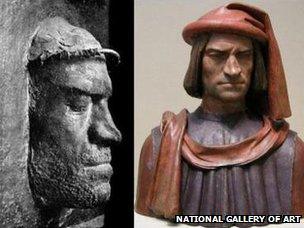Art research effort aided by face recognition
- Published

The facial recognition software can spot sculptures of Lorenzo de' Medici working only from his death mask
Face recognition could soon be helping art historians work out whom a portrait or sculpture depicts.
Researchers in California have been given cash to develop the software which can analyse faces in paintings, drawings, sculptures and other objects.
Early work has shown the software can correctly identify sculptures of Lorenzo de' Medici from his death mask.
The software should also be able to cope with the different styles of artists portraying the same person.
ID parade
While the people depicted in portraits were well known in their day, many of those identities have been lost over time, said Conrad Rudolph, a professor of art history at the University of California Riverside, who is part of the face recognition team.
The software under development by Prof Rudolph, engineer Amit Roy-Chowdhury and art historian Jeanette Kohl will try to put a name to these forgotten likenesses by grabbing data about defining elements of faces from portraits and comparing them to known depictions.
Early work on the project established that key parameters for facial recognition in portraiture include the position of the corners of the eyes and mouth, the width between the eyes, and the width of the mouth. Mapping these characteristics using a 27-point scheme captures sufficient information to make identifications, said the researchers.
"The methods developed need to be invariant to the style of specific artists, appropriate facial features have to be identified, and these need to be done with limited data that can be authenticated by experts like art historians," said Prof Roy-Chowdhury in a statement.
The techniques developed have to work with paintings in different media as well as sculptures, all of which vary according to the defining working methods of the artist who produced them and the techniques available during the era when that person was alive.
In addition, said Prof Rudolph, the software has to cope with the way an artist uses a portrait to say something about the wider life of their subject.
"It looks like you, but better," said Prof Rudolph. "That makes it harder to use face-recognition technology, which doesn't deal with highly subjective images. This is a painstaking process."
The trio have won a $60,000 (£40,000) grant from the National Endowment of the Humanities to apply the software to portraits and start the process of identification.
Early subjects will include Dante, Brunelleschi, Lorenzo de' Medici, Henry VII and Anne Boleyn as well as many important papal portraits. They also plan to use it on many Renaissance portraits of unidentified women and supposed self-portraits of Mantegna and Michelangelo.
Eventually the team hopes to apply their work to several portraits that are claimed to be depictions of Shakespeare and help resolve which most accurately captures the face of the playwright.
- Published9 April 2013
- Published28 May 2013
- Published6 March 2013